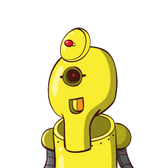To the casual observer, the Goosinator is quite a funny robot. It’s almost neon orange with bright yellow glaring eyes, zips as fast as 25 mph, and emits an incredibly annoying whine. What is its purpose? To scare away the many geese that infest Denver’s parks.

In the city of Denver, there were often complaints about the behavior of geese. The designer of this robot, Randy Claussen, created this robot in order to scare geese by adding one factor of the natural environment of all animals: predators. He created this robot to emulate the behavior of a predator that might prevent the geese from settling into the urban sprawl.
But what’s so bad about geese, you might ask. Well, the primary problem is their fecal excrement. Each goose produces at least a pound a day of feces, and citizens are annoyed because of the constant maintenance and cleaning this requires. And with seven hundred permanent residential geese and tens of thousands of others that join them during migration, this problem is pretty messy.
This robot chases geese no matter where they run, maneuvering over land, water, ice, and snow, all to scare geese away. It’s 82 decibel whine essentially scares the geese away, and studies have shown that they don’t return, at least for the short term. The only detriment in terms of the robot design is that the Goosinators are remote-controlled, requiring human operators.
However, the general purpose of the Goosinators has received criticism as well. When the geese are chased away, they can relocate in a variety of different places, like national parks, where their damage could be much worse. Also, some experts on geese behavior have conjectured that this method won’t last for long. Apparently, geese will quickly learn how to avoid the Goosinators. Only time will tell.
This sort of environmental influence of robots seems to be a pioneer. Even in this one example, we see that there is a large controversy primarily because living organisms are involved. While this might be a wrong place to branch out into a larger debate about the viability of robotics in the environment, it certainly sets the stage for more ways for humans to control nature and could have larger, global impacts.


















































